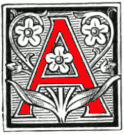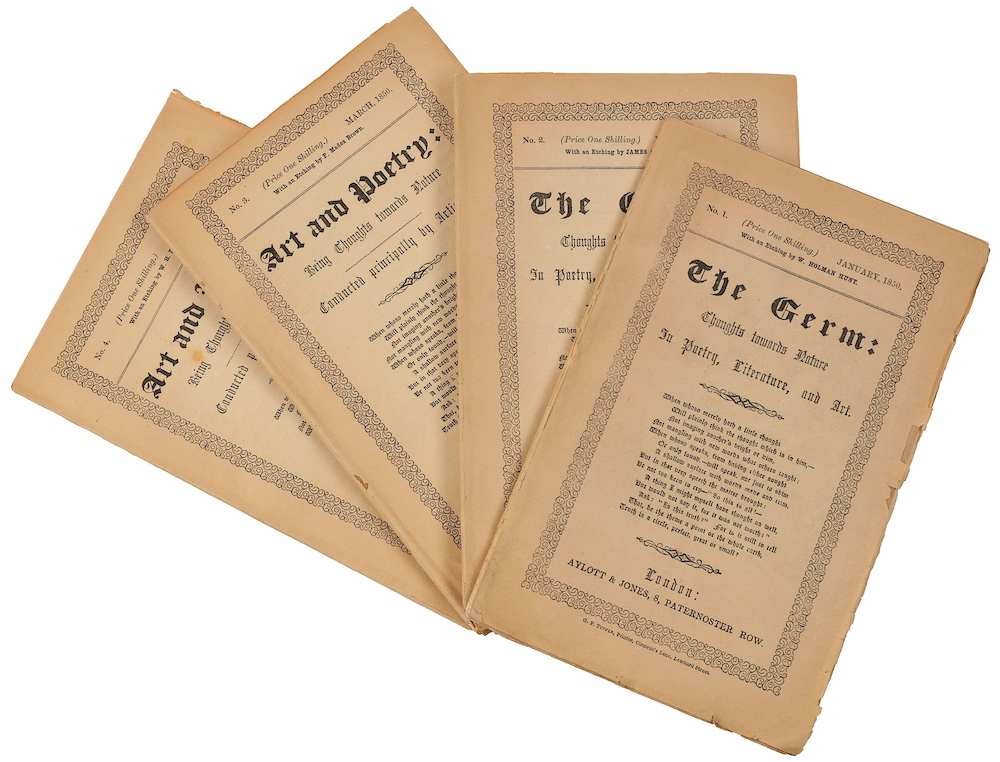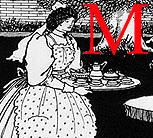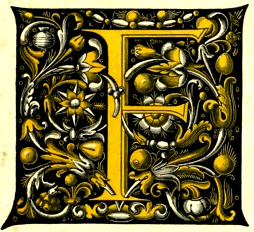This page is updated regularly. Please refresh the screen to see the latest news.
April 2025

pril's first news item is that Dennis T. Lanigan has now finished revising and enlarging our section on the paintings of the Pre-Raphaelite artist, Arthur Hughes. This brilliant series of commentaries has kindly been proofread for us by another art historian, Scott Buckle, who, as usual, added some useful suggestions of his own. One such suggestion was about the influence of Hughes on Lewis Carroll, who admired Hughes tremendously: of his visit to the Royal Academy, Carroll wrote: "I could find no pictures more beautiful than Arthur Hughes's Music Party, though many were very beautiful." Scott joins in the debate about whether Carroll's portrayal of Alice was influenced by Hughes's The Lady with the Lilacs. Nothing on our website is seen in isolation!
In that connection, one of the new intiatives of our Managing Editor, Diane Josefowicz, has been to start suggesting tours of the website. Do look at our new page listing her first few recommendations, and remember that clicking on "next" at the top of every page can lead you into all sorts of surprising corners of the Victorian world.
Like Dennis Lanigan, JB also completed a new project, albeit a much smaller one, in the visual arts: to introduce the "Rogue Gothic" architect E. Barrett Keeling, and give some examples of his work, such as St George's church on Campden Hill, Kensington (still there, though altered), and the highly controversial, very short-lived but unexpectedly influential Strand Music Hall (demolished). Many thanks to contributing photographer John Salmon for providing some lovely photographs of the church.
JB opened another new section, too, this time on Frederic Villiers, whose on-the-spot battlefield sketches and escapades made him a legend in his own lifetime — although an "at home" interview with him in the late nineteenth century does suggest some reasons why his fame hasn't travelled well.
Nevertheless, he had his impact at the time — a time when illustration, generally, was having a major and even transformative influence on readers, authors, artists and publishers alike. This makes our next item, a book review from our Senior Editor, Simon Cooke, particularly important. Simon examines Julia Thomas's The Victorian Mind's Eye: Reading Literature in an Age of Illustration, and finds much to recommend it, suggesting that it provides a whole new conceptual framework for future scholars in the area.
Still in the illustration section, Contributing Editor Philip Allingham has completed his set of pictorial covers for the Graphic, each with a helpful commentary — a demanding project because the subjects are important topical events, from the conflicts in Serbia and Burma, to exhibitions in big cities like Edinburgh, to new theatres like the one in Oxford. These all required individual explanations and even more links than usual to (and from) material elsewhere on the website. They also involved a rearrangement and updating of the main and already substantial Graphic page. Here are numerous glimpses of the complicated, many-faceted and always fascinating age as it unrolled, by some of the best artist-illustrators of the time.
Two off-shoots of Philip's project are new works from the Graphic by John Gordon Thomson, who provided some of its most striking illustrations, like this one for F. E. West's "A Cottage by the Sea"; and the introduction of another new illustrator who contributed to the journal over several decades: Edward Killingworth Johnson. Johnson's best-known commission was to illustrate H. Rider Haggard's She: A History of Adventure on its first appearance there — these illustrations are yet to come. Meanwhile, Philip expanded his earlier work on Dickens's chair — yes, that famous one which captured the imagination when he left it, forlornly empty, at the end of his busy life.

Another well-developed area of our website is the section on the Pre-Raphaelite artists, and here Dennis T. Lanigan has just come forward again with an account of the Germ and the etchings contributed to it by various leading members of the brotherhood. A good example (indeed the best) is the pair of etchings contributed by William Holman Hunt, My Beautiful Lady and Of My Lady in Death.
Dennis's last contribution for the month is about the sculptor Thomas Maclean, giving a brief biography of him and a full account of his sculpture, Ione, a very attractive work commended by one critic as "entirely fresh and natural" — a good example of the New Sculpture.
Please note that such projects are rarely if ever truly complete. There are many more paintings by Arthur Hughes, hundreds more Graphic covers, many more talented illustrators, etc. etc. Our site is always growing. The longer daylight hours bring more temptations to leave the desk. Still, our industrious editors and contributors continue to enrich the website!
March 2025

arch seemed to ambush us: there were tight deadlines for submissions for some of our new conference announcements, but if you missed the dates for William Morris and Material Culture and Oscar Wilde's Francophilia, there is still a range of other tempting topics to choose from. The first deadline next month (1 April!) is for the Rocky Mountain Modern Language Association's 78th Annual Convention in Spokane, which offers opportunities to those working in any area of nineteenth-century studies.
Online in the Victorian Web this month is a whole variety of new pieces. Inspired by the new play about her (The Vegan Tigress, mentioned in February's "What's New"), JB has written an introduction to Mary De Morgan, whose subversive fairytales, feminism and political beliefs have been overshadowed by the achievements of her more famous brother and sister-in-law, William and Evelyn De Morgan. She also added a review of two books on the eighties: Nineteenth-Century Literature in Transition: The 1880s, edited by Penny Fielding and Andrew Taylor, and Literature, Print Culture, and Media Technology, 1880-1900, by Richard Menke. The first chapter in the former features two paintings, Evelyn De Morgan's Maidens of the Sea, and Edward Burne-Jones's The Depths of the Sea, which are now discussed on our website too.
Photographs sent in by one of our contributors, Lucy Paquette, enabled JB to include statues of Queen Victoria (by Sir Joseph Edgar Boehm) and Prince Albert (by William Theed) in Sydney; more to come here. These were followed by photographs of a splendid stained glass window by Stephen Adam in Buenos Aires, taken by Alejandro Vetere, Director of a school housed in a beautiful old mansion there, where the window brightens a staircase. It turns out that the mansion was built in 1888 by an English official of the Western Railway, living in Argentina. How the Victorians and their work travelled!
Another place they travelled to was Africa, where our Senior Editor, Simon Cooke, has taken a close look at an uncomfortable subject that we haven't covered before: the Anglo-Zulu war. How did we see it then? How was it represented in contemporary illustrations (in newspapers, periodicals and cartoons), photographs and military paintings, and how have we revisited it in film since then? Simon's fully-illustrated essay, with its interdisciplinary approach, is both fascinating and instructive.
Meanwhile, Philip Allingham, our Contributing Editor from Canada and an expert on Dickens illustrations, has turned aside from his favourite author for a while to revise and rescan Robert Barnes's illustrations for Hardy's The Mayor of Casterbridge. Here's one of the latest, with some interesting comments on costume in the 1840s: Farfrae was footing a quaint little dance with Elizabeth-Jane. This was followed by galleries of his work (which is really worth discovering), including one in which Philip skilfully brings together his contributions to periodicals.
Once again, we are putting on line a whole set of new commentaries on a Pre-Raphaelite artist by Dennis T. Lanigan. This month it's the turn of Arthur Hughes. Already complete are a new biography for him, and discussions and contemporary reviews of such favourites as his Ophelia and April Love. Many more have have followed, and Dennis has sent in images of his stained glass series on Tristram and Isoude, starting here, which are far better than the ones we already had (in colour, for one thing). An essay on Hughes's justly admired illustrations to Christina Rossetti's Sing-Song completed his wide-ranging body of new work on Hughes. Dennis has also kindly contributed a portrait to JB's new section on Mary De Morgan, and, in the painting section, two of the later watercolours of Inglis Sheldon-Williams, like this one, Showery Weather, rather suitable to the present season.
Correspondence: Alden Loveshade and Lily Alexander have both done some useful proofreading for us (in other words, they spotted typos, and took the trouble to write in about them!). As usual, that is very, very welcome. Philip Parker of the Lynchpin Theatre kindly allowed us to reproduce a still from the company's acclaimed production of The Vegan Tigress about Mary De Morgan. We are also grateful to Ray Russell for querying a rather important detail in our brief introduction to the artist and illustrator Joseph Syddall, and this has duly been corrected.
February 2025

ebruary strikes again, with its blasts of cold air. However, we extend a warm welcome to our readers, and are very happy to report that we already have an abundance of new work on the desktop (if not yet online). Note that the deadline for submissions to the Conference of the International Walter Pater Society at Cornell (7 February) has now passed, but, thanks to our editorial assistant Nigel Finch, new conferences have already been added, so check out our listing, and note especially that submissions for Patrick Leary's generous Field Development Grant (The Research Society for Victorian Periodicals) need to be in by 15 March. That's not far ahead, either!
Readers might like to know that our Managing Editor, Diane Josefowicz, continues to liaise with our technical team on future improvements to the website, to take charge of the conference listings, and to arrange for book reviews; while our History Editor, Dory Agazarian, is also working behind the scenes to build up our podcast project, "What the Dickens?!" Have a listen to the entertaining and informative episodes that Dory has already presented, and don't forget we also have list of recommended podcasts from other sources.
In amongst her own editing duties, JB finished two new book reviews at the turn of the last month. One is of Joan Grant's booklet, It's not Notting Hill, It's Ladbroke Grove, which discusses some Victorian buildings in that part of London. This inspired new accounts of the Elgin pub, with its wonderful interior, and St Charles' Hospital (built for the "sick poor"), both still serving the community in their very different ways. The other review is of Nicholas Olsberg's hugely impressive and very enjoyable The Master Builder: William Butterfield and His Times. This in turn entailed some new work, notably, on Butterfield's chapel and New Big School projects at Rugby.
Coming across a wonderful old print of the Greenwich Railway Viaduct (opened 1836, the first elevated train service in the world!), JB also wrote a piece on that, and was intrigued to see a little windmill sitting beside the new structure, in a rural landscape. Some people complained about the loss of nature then. What would they say if they saw the area now? On another topic entirely, JB discussed John Tenniel's Punch cartoon, The Haunted Lady, or 'The Ghost' in the Looking-Glass, a comment on the exploitation of seamstresses who catered for the rich and fashionable, and its sometimes tragic results. And on yet another topic, JB introduced and added an excerpt from the Illustrated London News's report on Doulton's display at the Paris Exhibition of 1873, which reveals the methods of producing their award-winning ceramics, and the number of women designers involved.
Our Senior Editor, Simon Cooke, started the month with a real scoop: Richard Doyle's quirky illustrations from a very rare little book, The Christening Procession of Prince Taffy (1842), starting with this funny but touching one of Queen Victoria carrying her new first-born at arm's length on a cushion, ahead of her own mother, her wet and dry nurses, etc. (the wet nurse being suitably well endowed). So this is how the future Edward VII entered the public stage!

Also rare is a new set of mainly colour "Character Sketches" by the Dickens illustrator Fred Barnard. These are being put online by our Contributing Editor for Canada, Philip Allingham. The latest depicts Dick Swiveller and the Marchioness from The Old Curiosity Shop, and Philip has written a comprehensive essay about the various illustrators' versions of this quintessentially Dickensian pair. Many more have followed since then, perhaps the most dynamic being this one (left) of Barnaby Rudge, with his pet raven, Grip. Each is beautifully reproduced and, of course, since this is Philip's area, fully discussed. Why not cycle though them, starting (where better?) with the unforgettable Mrs Gamp? Just follow the "Next," either in the arrows at the top of the page, or in the blue tile at its foot.
We are really fortunate with our new material this month: art historian Dennis T. Lanigan has just opened a section on the artist and activist Barbara Bodichon. Apart from discussing some lovely examples of her watercolours, such as View from my window: Maentwrog, Snowdonia, Wales, he has written a very informative essay on three drawings of Lizzie Siddal by Bodichon herself, Anna Mary Howitt and Dante Gabriel Rossetti, from Lizzie's trip to Hastings for her health — poignant enough in view of her already all-too-apparent frailty. Many thanks to Dennis's fellow art-historian, Scott Buckle, for proof-reading the section and making some helpful suggestions here.
Informative in a completely different area is an essay dedicated to Rita Wood, who suggested the topic, but, sadly, is no longer here to see it online — Susan Major, a new contributor, has written about Scoria Bricks in the Back Alleys of York. Scoria production was started in the mid-Victorian period by Joseph Woodward, who saw a unique recycling opportunity in the accumulation of industrial waste.... yet another example of the Victorians' ingenuity and can-do mentality.
Back to Dickens (who is never very far from the mind in Victorian studies): Peter J. Capuano kindly won permission from Cornell University Press to share with us two extracts of his recent book, Dickens's Idiomatic Imagination: The Inimitable and Victorian Body Language. One is on Bleak House, the other on Our Mutual Friend. These are especially interesting for the light they throw not only the novels but on their author, and for the way they show how digital tools can aid close reading of the text. Michelle Allen-Emerson's review of the whole book helps to put these extracts in context: we're grateful to Review 19 for letting us reprint such reviews here.
Many thanks, too, to Shirley Nicholson for some much-needed proof-reading (do please volunteer for this useful task, if you have time and inclination!) and also for identifying two of our previously unattributed Punch cartoons, one of them a great personal favourite: "Welcome!" celebrates opening day at the (then) brand new National Portrait Gallery, where Victorianists can go to feel at home among old friends.
Towards the end of the month, we were delighted to receive Jeffrey Begeal's review of Florence’s English Cemetery, 1827–1877: Thunders of White Silence, by Julia Bolton Holloway. The cemetery is the last resting-place of Elizabeth Barrett Browning and so many others in the Anglo-Florentine community of Victorian times, and the book is the culmination of Julia Holloway's years of dedication to restoring it, and (with fellow members of the association founded for this purpose, like Jeffrey himself), researching its rich history.
Correspondence: Sarah Dean writes to inform us of her new website (www.richardansdell.co.uk) about her great-great-grandfather, the artist Richard Ansdell RA, best known for his paintings of animals. We also heard from Keith Wood about the latest updates to his state-of-the-art VR simulation of the Great Exhibition, which now includes another steam locomotive and Newcastle ornithologist John Hancock's taxidermy specimens. For more details, see here: https://store.steampowered.com/news/app/2618260/view/526459570713788802. Another heads-up: Philip J. Parker writes to remind us that it is the 175th anniversary of Mary De Morgan on Monday 24 February – the perfect time to catch the new play celebrating her work, The Vegan Tigress. This is running at Clapham's Bread and Roses Theatre in London just until 1 March. The reviews are excellent: "The writing is sharp, funny, and fast-paced... It was with childlike wonder that I soaked up this story." Want to know more? Read on at https://everything-theatre.co.uk/2025/02/review-the-vegan-tigress-bread-and-roses-theatre/ @LynchPinTheatre.
January 2025

Season's Greetings and best wishes from us all for a very happy and fulfilling New Year! As our Managing Editor, Diane Josefowicz, sends 2024 down into the archives, let's hope 2025 will enrich our website and make it even more diverse and rewarding. On a personal note, entering her fifth year as Editor-in-Chief, JB would like to express her gratitude to all who have continued to contribute, or started to contribute, during that time, as well as to the other members of the Foundation and Editorial Boards for their support. Following George Landow's highly knowledgeable and energetic leadership has been a challenge as well as a privilege, and the fact that the site is still growing and thriving is largely down to his inspiration. Thank you, George, as ever.
This may be the place to mention one of George's initiatives, which we plan to develop. He had started making some tours of different areas of the website, such as this one, of London buildings. Do try it! More will follow. And, as usual, please remember to check out the latest calls for papers. The topic of the 57th Annual VSAO (Victorian Studies Association of Ontario) Conference is particularly timely: "Victorian Conviviality and Entertainments" (and note that the deadline for submissions is 24 January).
Despite the distractions of the holiday period, several projects have continued or even come to fruition. Thanks to the good folk at St Augustine's of Hippo, Edgbaston, JB was able to add their splendid church to the new section on J. A. Chatwin, and Emeritus Churchwarden Stephen Hartland kindly sent in a highly entertaining newspaper clipping, in which a visitor extols both the area and the church, while slyly poking fun at local pretentions. This church's fine musical tradition reminded her of Henry Woodyer's St Martin's Church in Dorking, which has a memorial to Ralph Vaughan Williams, so that came in for some new attention (thanks to David Dixon for his photographs of the interior).
Another very rewarding project was completed soon afterwards: Philip Jackson sent in a series of five articles from the Lady's Pictorial profiling its women contributors, thus putting names (and sometimes faces) to them, and giving details about their careers. These could be incorporated into JB's new alphabetically arranged index to editors and journalists, making them easier to find. This is a brilliant new addition to the study of both the periodicals themselves, and women's huge contribution to this field. JB also added a review of Brigid Allen's joint biography of Emily Eden and her brother Lord Auckland. Emily accompanied her brother to India where he served as Governor-General, and was implicated in the disastrous aftermath of the First Afghan War. But, as her writings suggest, Emily was a fascinating character in her own right, and both siblings deserve re-assessment now.
Next, the Pre-Raphaelite Society allowed our Senior Editor, Simon Cooke (who established our link with it), to select and format for our website two of the essays from the latest issue of their journal. One is Cecilia Rose's intriguing and prize-winning essay. "A Secret Preoccupation: John William Waterhouse and the Occult." Thanks to Simon, we can now see how women's demonstrations of their esoteric powers went beyond séances and table-rapping, and inspired some of Waterhouse's most admired paintings. The other article that Simon selected, intriguingly entitled "An Elephant, a Rhino, and a Mickey Finn," is Kirsty Stonell Walker's examination of the effects of chloral on Dante Gabriel Rossetti's life and relationship with his model, Fanny Cornforth. Complex relationships come under scrutiny again, this time in literature, in Simon's own review of Katie R. Peel's recently published Readers and Mistresses: Kept Women in Victorian Literature.
In true Victorian spirit, Philip Allingham has been fully immersed in his local pantomime season, but has sneaked a little time to improve on some of the twenty-year-old scans in the Dickens gallery. One that shows Dickens standing nonchalantly in his porch at Gadshill is especially evocative. Other improvements were to his material on the Household Edition: the cover and frontispiece of the final volume are particularly handsome, but many more of the illustrations have now been rescanned and more fully considered. Another notable example is Fred Barnard's illustration of the wretched end of a degenerate, washed up on the bank of the Thames, in Sketches by Boz, an interesting example of the "Found Drowned" trope found in The Old Curiosity Shop (Quilp's death) and elsewhere. Philip also rescanned and added new material to illustrations of Michael Black's novel Three Feathers, which led JB to open a new section on this novelist (who was seen as the equal of Trollope and others in his time), with a short biography of him and an introduction to the novel itself.
Most exciting of all is the whole extended section on the artist William Dyce, with more than 20 paintings comprehensively discussed by Dennis Lanigan, all carefully proofread by Scott Thomas Buckle. This is a major contribution, because Dyce was influenced by or directly involved in so many of the important strands of nineteenth-century culture, from the German Nazarenes and the Pre-Raphaelites in art, to High Church Tractarianism, to scientific studies in astronomy and geology, and to photography. But paintings like Pegwell Bay and Christabel also stand alone as some of the most memorable masterpieces of the age.
Another holiday treat was to hear from our French translator, Sabrina Laurent, who added a number of James Tissot's paintings to our French section (where they certainly belong as well), including a poignant depiction of the ailing Mrs. Newton asleep in a Conservatory Chair [Mrs. Newton endormie sur une chaise dans la véranda].
More recently (mid-month) Laurent Bury has reviewed a new book in the promising new field of reception studies: Medievalism and Reception, edited by Ellie Crookes and Ika Willis. Several chapters discuss the way the Victorians responded to the Middle Ages, offering new approaches to the literature (including some works by women historians and novelists) and wider culture of the period.
With the end of the month already approaching, DJ has brought in an exciting new piece on Victorians and the Discovery of X-Rays by Nicole Lobdell, which is knowledgable, thought-provoking and enjoyable to read — exactly the qualities we seek to present. There's more than meets the eye here, indeed: had you ever thought, for instance, how this new discovery tied in with the Victorians' deep fascination with the unseen?
Correspondence: we were very sad to learn that Rita Wood, whom Simon introduced to us in 2019, and who built up our section on York architects, passed away at the end of last year. She had been unwell for a long time, but continued to contribute until very near the end, and we shall miss her greatly. Just to give you an idea of her work, here is her piece on the beautiful Chapter House at York Minster (as is apparent here, Rita loved and was especially knowledgable about church tiles).
Last modified 17 April 2025